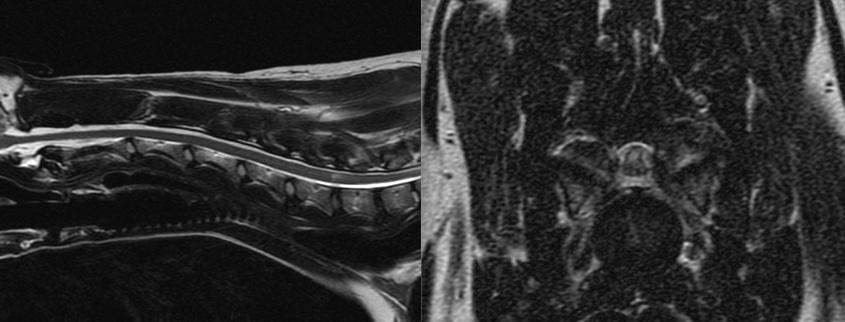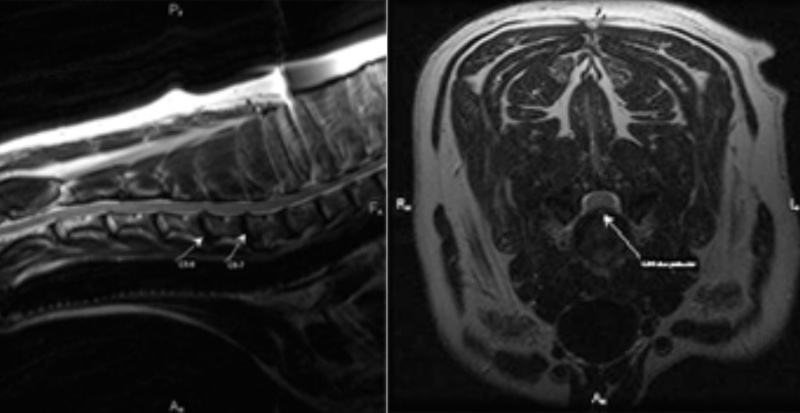Cervical spondylomyelopathy
Lisa Lipitz, VMD, DACVIM (Neurology)
Neurology/Neurosurgery, Bush Veterinary Neurology Service, Rockville, MD
Posted on 2018-03-29 in Neurology.
Today’s post was originally published in Neurotransmitter, Bush Veterinary Neurology Service’s online newsletter. Modified and reprinted with permission.
Cervical spondylomyelopathy (CSM) is often referred to as “Wobbler Syndrome”
Why you may ask? Because affected dogs have a wobbly gait!
CSM is a disease that affects the cervical spine in large and giant breed dogs. The etiology is multifactorial and thought to represent a combination of genetic, nutritional, and degenerative causes. Important factors include congenital vertebral canal narrowing, vertebral body instability, disc degeneration and protrusion, joint capsule proliferation and osteophyte formation, and hypertrophy of the ligaments that surround the spinal cord. The most common clinical sign is a chronic, progressive gait disturbance which can range from mild to severe tetraparesis and proprioceptive ataxia affecting all four limbs. Cervical pain and low head carriage may also be seen.
There are two types of CSM recognized in dogs: disc-associated and joint-associated.
- Disc-associated CSM (see figure) is seen in middle-aged to older large breed dogs. Doberman Pinschers are most often affected, followed by Rottweilers and Bernese Mountain Dogs. Spinal cord compression most commonly occurs at C5-6 and C6-7 due to Type II disc degeneration and protrusion (leading to ventral compression); thickening of the vertebral ligaments and vertebral body instability may also contribute to cord compression.
- Joint or osseous-associated CSM is a disease of young adult giant breed dogs such as Great Danes and Mastiffs. Spinal cord compression usually occurs at C2-3 and C3-4 due to a proliferation of the articular facet joints (leading to dorsolateral compression).
Diagnosis
Imaging of the cervical spinal cord with an MRI examination or a CT/myelogram study demonstrates the location and extent of cervical spinal cord compression. Lesions can also be classified as dynamic (compressions that worsen or improve with different neck positions) or static.
Treatment and prognosis
There are two treatment options for CSM: conservative medical therapy and surgical treatment.
Medical therapy
Medical therapy involves anti-inflammatory medication with prednisone or non-steroidal anti-inflammatory agents, physical therapy, periods of exercise restriction, and pain medication (often with gabapentin). Reports of success are variable; two large retrospective studies have found that between 45-54% of dogs treated medically improve in the short term; however, neurological deficits and pain progressed in the majority of affected dogs from both studies over the long term.1,2 Progression of disease may result in humane euthanasia due to poor patient quality of life and the difficulty for pet owners in trying to manage a large breed dog with limited mobility.
Surgical treatment
Surgical treatment may be recommended based on several factors including the degree of neck pain, the severity of neurologic dysfunction, the degree of spinal cord compression seen on MRI examination, and lack of response to medical management. There are many different types of surgical techniques described and in some instances, there may be a disparity in agreement as to which procedure carries the best outcome. The treatment for disc-associated CSM is typically ventral slot surgery at the site of disc protrusion (stabilization may be necessary in cases with dynamic compressions). For joint-associated CSM, decompression of the spinal cord via dorsal laminectomy is most often performed. The majority of authors claim a 70-80% success rate with surgical therapy; therefore, the majority of surgically managed patients improve in the short term.3 However, over the long-term, CSM can continue to progress in up to 50% of affected dogs in spite of surgical therapy again eventually resulting in poor patient and owner quality of life. This is due to several factors, most importantly, the development of spinal compression at other sites along the cervical spine (termed “adjacent segment disease”).
Summary
In summary, both medical and surgical treatment can benefit dogs with CSM in the short term. However, long-term this disease has the potential to progress with either methodology. The choice of which treatment best suits each individual patient must take into account many factors; most importantly, the short and long term expectations of each individual owner must be taken into consideration so that an informed decision can be made on their dog’s behalf.
References
- De Decker S et al. Clinical evaluation of 51 dogs treated conservatively for disc-associated wobbler syndrome. Journal Small Animal Practice.
2009; 50, 136-142. - Da Costa R, et al. Outcome of medical and surgical treatment in dogs with cervical spondylomyelopathy: 104 cases (1988-2004). 2008; 233(8),
1284-1290. - Da Costa. Cervical Spondylomyelopathy (Wobbler Syndrome). Vet Clin North Am Small Anim Practice 2010;40(5):881-913.
About the author
Prior to relocating to the Maryland/DC area, Dr. Lipitz worked as a staff Neurologist at a specialty and emergency hospital in Coral Springs, Florida. Dr. Lipitz enjoys lecturing and has given continuing education seminars to veterinarians as well as presented her research at the ACVIM conference. She has several publications to her credit in the areas of infectious brain disease, neoplastic brain disease, and congenital spinal disorders. Outside of work, Dr. Lipitz enjoys spending time with her husband Chad, their son Chase and daughter Cate, and lovable Labrador, Keyes. |



 Dr. Lipitz, a New Jersey native, received her undergraduate and Doctorate of Veterinary Medicine degrees from the University of Pennsylvania. She completed a small animal rotating internship at Tufts University in 2005. Following this academic training, Dr. Lipitz worked in private practice for three years as an emergency and critical care veterinarian at the Veterinary Specialty and Emergency Center in Langhorne, Pennsylvania. In 2008, Dr. Lipitz went on to complete her Neurology and Neurosurgery residency at the University of Wisconsin-Madison; she received her ACVIM Board Certification in June of 2011. Dr. Lipitz completed additional continuing education and earned her ACVIM Certificate of Neurosurgery Training in May of 2012.
Dr. Lipitz, a New Jersey native, received her undergraduate and Doctorate of Veterinary Medicine degrees from the University of Pennsylvania. She completed a small animal rotating internship at Tufts University in 2005. Following this academic training, Dr. Lipitz worked in private practice for three years as an emergency and critical care veterinarian at the Veterinary Specialty and Emergency Center in Langhorne, Pennsylvania. In 2008, Dr. Lipitz went on to complete her Neurology and Neurosurgery residency at the University of Wisconsin-Madison; she received her ACVIM Board Certification in June of 2011. Dr. Lipitz completed additional continuing education and earned her ACVIM Certificate of Neurosurgery Training in May of 2012.
